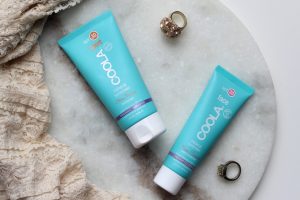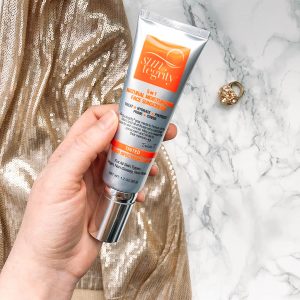
Summer is officially here! Now, more than any other time of the year, sunscreen is a must for extended periods spent outdoors. But in a sea of consumer options, finding the right sunscreen can be tricky. Here’s how to choose greener options and stay sun safe this summer.
BY JACLYN IRWIN, CNP
If you want to enjoy being outside (who doesn’t?!), then it’s important to make sure you’re protected. But conventional sunscreens contain a litany of worrying chemicals that have been directly linked to health issues like hormone disruption, contact dermatitis and cancer.
It’s time to have a closer look at those sunscreens we’re slathering on ourselves. If you’re looking to make the switch (who isn’t?!), then natural and nontoxic sunscreens are the way to go this summer.
As a holistic nutritionist and clean beauty expert, it’s my mission to find and share the safest sunscreen options so that you can lay back and enjoy the summer. But please note, I don’t believe in avoiding the sun completely.
The sun is crucial to get adequate vitamin D, an important hormone that’s responsible for bone health, brain health and a strong immune system. Sure, we can take a vitamin D supplement, but 10 to 20 minutes spent in the sun, sans sunscreen, will provide your daily dose of the sunshine vitamin.
Of course, be smart about it and get that sun exposure while it’s still early in the day and the rays aren’t too strong. After noon, if you’re going to be in the sun, cover up and use a safe, natural sunscreen.
The Problem with Conventional Sunscreen
Many of the sunscreens on the market today are made with questionable ingredients that can, unfortunately, have long-term negative effects on our health. This is especially true due to the way we apply sunscreen: either via spray, which can end up being ingested, or via a thick coating we reapply throughout the day (it sits on the skin).
Specific Ingredients to Avoid
Oxybenzone, Octinoxate and Homosalate are the active ingredients in most conventional sunscreens and are documented hormone disruptors. Oxybenzone is particularly troublesome as it’s easily absorbed by the skin and transported throughout the body. It’s often found in breast milk.
The remainder of ingredients found in most conventional sunscreens include inactive compounds like preservatives, which make up about 50 to 70 percent of the final product.
The preservative Methylisothiazolinone is a common allergen when exposed to the skin and can cause redness, itching, inflammation and irritation where it’s applied.
Retinyl Palmitate, a form of vitamin A, is also added to chemical sunscreens as manufacturers believe that it slows aging of the skin. But some studies show that vitamin A in sunscreen could actually speed up the development of cancerous growths on skin exposed to the sun.
Other ingredients like paraben preservatives can also be added to conventional sunscreens. These can mimic estrogen and interfere with male reproductive functions.
In addition, avoid petrochemicals, such as petrolatum, mineral oil and paraffin wax, and silicones, such as dimethicone, as these can clog pores and contribute to potential issues with the lymphatic system.
The Switch to Natural Sunscreen
Avoid the chemical soup and its unwanted health effects by switching to a more natural, organic sunscreen. If you’ll be spending quite a bit of time in the sun, it’s wise to protect your skin safely using a mineral-based product.
Don’t forget, just as you would apply and reapply with conventional sunscreen, you must also apply and reapply a mineral or natural one as well. If you’re in and out of the water, be sure to reapply after each swim as well.
When it comes to mineral sunscreen products, the two primary active ingredients are titanium dioxide and zinc oxide. Both sit on the skin without being absorbed, but titanium dioxide doesn’t protect against UVA rays as well as zinc does.
Other beneficial ingredients to look for when it comes to sunscreen include oils that provide SPF protection naturally, such as pomegranate seed oil, carrot seed oil and red raspberry seed oil. Green tea extract gets bonus points for its antioxidants and its hyaluronic acid for hydration.
Some natural sunscreens can be chalkier than others due to the minerals they contain, and each product is different. For that reason, when shopping for a natural sunscreen, it’s best to try it out on yourself before you buy.
Most natural sunscreens are waterproof and should say so right on the bottle. Be sure to always reapply as needed to be safe. You can find natural sunscreen products at well-stocked health food stores and natural beauty stores (both online and in-store).
And, in case you don’t want to think too hard about it, here’s a short list of some specific natural brands that I use and recommend: Coola, Suntegrity, Hynt Beauty Sun Prep, Raw Elements, Josh Rosebrook, Kypris and Living Libations.


Holistic Nutritionist Jaclyn Irwin aims to help women end years of yo-yo dieting and develop a healthier relationship with food. As founder of Holistic Foodie, a food and lifestyle website filled with delicious and nutritious recipes, realistic and practical plans, and green beauty inspiration, she is creating a space for women to discover their inner holistic foodie. Learn to love food again by following her on Instagram (@holistic.foodie), and be sure to check out all the goods at holisticfoodie.com. Download her free ebook, Get The Glow at holisticfoodie.com/ebook.
